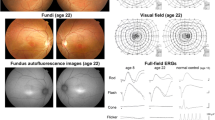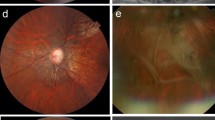Summary
Fourteen achromats were re-examined with special attention to the course of dark adaptation. According to the degree of colour deficiency and the range of flicker fusion frequency in the ERG there were 10 cases of complete achromatopsia and 4 cases with incomplete forms. The cases with complete congenital achromatopsia presented a uniform picture: the subjects affected were not able to distinguish colours at all; the ERG showed subnormal amplitudes of a- and b-waves and a flicker fusion frequency with a maximum of 10 cps according to the lack of photopic components; the course of dark adaptation was monophasic within the normal range or near to it.
The patients with incomplete forms of achromatopsia varied in many respects: their ability to discriminate between colours was affected to varying extents; the amplitudes of a- and b-waves in the ERG were near the upper limit of normal in 3 cases and subnormal in one, and the flicker fusion frequency was between 35 and 45 cps; the threshold of dark adaptation was almost normal in one case and elevated in 3 cases.
In a 15th case, a boy now 13 years of age, the clinical symptomatology and the scotopic ERG had led to the diagnosis of an incomplete form of achromatopsia 5 years earlier. Rechecks revealed that his defective colour vision was continuing to deteriorate and that the ERG-amplitudes had decreased. Therefore this case had to be re-classified as one of progressive retinal degeneration with special involvement of the cone mechanism.
Finally the pathogenesis of congenital achromatopsia and its probable relationships to heredodegenerative retinopathies are discussed.
Zusammenfassung
Die Prüfung der Dunkeladaptation von 14 Patienten mit angeborener totaler Farbenblindheit ließ bei den 10 Fällen mit kompletter Form keinen wesentlichen Unterschied zum Kurvenverlauf der normalen Kontrollgruppe erkennen. Die Endschwellen der Dunkeladaptation der 4 Personen mit inkompletter angeborener Farbenblindheit lagen bei 3 über dem Normbereich und waren einmal etwa normal. Die Verlaufskontrolle eines weiteren Patienten, dessen Sehstörung ursprünglich in den Formenkreis der kongenitalen Achromatopsie eingereiht worden war, ergab, daß es sich bei ihm um eine progressive Degeneration des Zapfen- und Stäbchen-apparates handelt.
Similar content being viewed by others
Literatur
Alpern, M., Falls, H. F., Lee, G. B.: The enigma of typical total monochromacy. Amer. J. Ophtal. 50 (II), 997–1011 (1960).
Arden, G. B., Barrada, A., Kelsey, J. H.: New clinical test of retinal function based upon the standing potential of the eye. Brit. J. Ophthal. 46, 449–467 (1962).
Best, F.: Untersuchungen über die Dunkelanpassung des Auges mit Leuchtfarben. (Mit Beitrag zur Buntfarbenblindheit und Nachtblindheit.) Z. Biol. 68, 11 (1917). Zit nach Walls u. Heath.
Elenius, V., Heck, J.: Vergleich zwischen der b-Wellenamplitude und dem Verlauf der Sehpurpurregeneration bei Achromaten und Gesunden. Ophthalmologica (Basel) 136, 145–150 (1958).
Enoch, J. M.: Amblyopia and the Stiles-Crawford effect. Amer. J. Optom. 34, 298–309 (1957).
Enoch, J. M.: Optical properties of the retinal receptors. J. opt. Soc. Amer. 53, 71–85 (1963).
Enoch, J. M., Fry, G. A.: Characteristics of a model retinal receptor studied at microwave frequencies. J. opt. Soc. Amer. 48, 899–911 (1958).
Falls, H. F., Wolter, J. R., Alpern, M.: Typical total monochromacy. Arch. Ophthal. 74, 610–616 (1965).
Forbes, L. M., Mote, F. A.: A comparison of the variability of binocular and monocular threshold measurements during dark adaptation in the human eye. J. comp. physiol. Psychol. 49, 431–436 (1956). Ref. Zbl.ges. Ophthal. 71, 125–126 (1956).
Franceschetti, A., Jaeger, W., Klein, D., Ohrt, V., Rickli, H.: Étude pathophysiologique et génétique de la grande famille d'achromates de l'ile de Fur (Danemark). XVIII. Conc. ophthal. Belgica, II 1582–1588 (1958).
François, J., Verriest, G., De Rouck, A.: L'achromatopsie congenitale. Docum. ophthal. (Den Haag) 9, 338–424 (1955).
François, J., Verriest, G., De Rouck, A.: L'électro-oculographie en tant qu'examen fonctionnel de la rétine. Progr. Ophthal. Otolaryng. 7, 1–67 (1957).
Goodman, G., Ripps, H., Siegel, I. M.: Cone dysfunction syndromes. Arch. Ophthal. 70, 214–231 (1963).
Granit, R.: Processes of adaptation in the vertebrate retina in the light of recent photochemical and electrophysiological research. Docum. ophthal. (Den Haag) 1, 7–77 (1938).
Harrison, R., Hoefnagel, D., Hayward, J. N.: Congenital total color blindness. Arch. Ophthal. 64, 685–692 (1960).
Heilig, P., Thaler, A.: Minimum duration of dark adaptation in clinical ERG. VIII-th Symposium of Iiscerg 1970 Pisa, p. 331–338. Pisa: Pacini 1970.
Klein, D.: Persönliche Mitteilung 1971.
Krawkow, S. W.: Über die Helligkeits- und Adaptationskurven der total Farbenblinden. Albrecht v. Graefes Arch. Ophthal. 118, 285–291 (1927).
Krill, A. E.: The electroretinogram in congenital color vision defects. The clinical value of electroretinography. Iiscerg Symp. Ghent 1966, p. 205–214. Basel-New York: Karger 1968.
Larsen, H.: Demonstration mikroskopischer Präparate von einem monochromatischen Auge. Klin. Mbl. Augenheilk. 67, 301–302 (1921).
Merin, S., Auerbach, E.: The central and peripheral retina in macular degeneration. Arch. Ophthal. 84, 710–718 (1970).
Rushton, W. A. H.: Dark-adaptation and the regeneration of rhodopsin. J. Physiol. (Lond.) 156, 166–178 (1961).
Rushton, W. A. H.: Rod/cone rivalry in pigment regeneration. J. Physiol. (Lond.) 198, 219–236 (1968).
Sloan, L. L.: Congenital achromatopsia: a report of 19 cases. J. opt. Soc. Amer. 44, 117–128 (1954).
Sloan, L. L., Brown, D. J.: Progressive retinal degeneration with selective involvement of the cone mechanism. Amer. J. Ophthal. 54, 629–641 (1962).
Sloan, L. L., Newhall, S. M.: Comparison of cases of atypical and typical achromatopsia. Amer. J. Ophthal. 25 (II), 945–961 (1942).
Sundmark, E.: The contact glass in human electroretinography. Acta ophthal. (Kbh.), Suppl. 52, 1–40 (1959).
Teterina, T. P.: Heredodegeneration der Macula lutea in fünf Generationen. Vestn. Oftal. 83, 60–64 (1970). Ref. Zbl. ges. Ophthal. 104, 133 (1970).
Thaler, A., Heilig, P., Slezak, H.: Kombination einer angeborenen Achromatopsie mit sektorenförmiger Degeneratio pigmentosa retinae. Albrecht v. Graefes Arch. klin. exp. Ophthal. 183, 310–316 (1972).
Verriest, G., Seki, R.: Nouveaux cartons pseudo-isochromatiques destinés à la reconnaissance d'une vision de type scotopique. Farbe 14, 229–239 (1965); 15, 21–31 (1966).
Walls, G. L.: Congenital total color-blindness. Comment. Surv. ophthal. 1, 277 (1956).
Walls, G. L., Heath, G. G.: Typical total color blindness reinterpreted. Acta ophthal. (Kbh.) 32, 253–297 (1954).
Yonemura, D., Aoki, T.: Dark adaptation curve of the totally color blind eye as measured by ERG. Rinsho-Ganka 14, 429–432 (1960).
Author information
Authors and Affiliations
Additional information
Die Autoren danken Herrn Prof. Dr. F. X. Wohlzogen, Vorstand der Lehrkanzel für medizinische Statistik und Dokumentation der Universität Wien, für die wertvolle Beratung.
Rights and permissions
About this article
Cite this article
Frey, R.G., Heilig, P. & Thaler, A. Die Dunkeladaptation der Achromaten. Albrecht von Graefes Arch. Klin. Ophthalmol. 186, 55–65 (1973). https://doi.org/10.1007/BF00410079
Received:
Issue Date:
DOI: https://doi.org/10.1007/BF00410079




